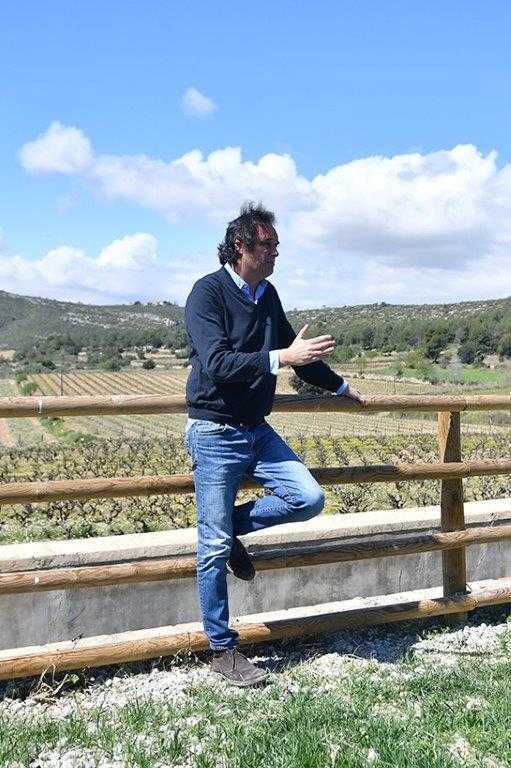The Color: The First Clue in Your Wine Glass
Have you ever wondered what the color of wine is telling you before you even smell or taste it? That hue, from a pale, brilliant yellow to a deep, opaque purple, is the wine’s first calling card. At Vila de Llops, we believe it’s much more than that: it’s the first reflection of our unique landscape, a liquid mirror of the sun, the calcareous soils, and the Mediterranean breeze of the Massís del Garraf.
In this guide, we invite you on a journey from our organic vineyards to your glass. You will discover why our Garnatxa has its ruby color and our Xarel·lo its golden hues, learning to read each wine like a true expert.
The Origin of It All: The Color Palette of Our Vineyards
The true color is born in the plant, a result of the dialogue between the grape variety and its environment. At the Finca Viladellops, we practice organic farming to ensure the color expression of our native grapes is as pure and honest as possible.
Garnatxa: The Red Soul of the Garraf
Our red Garnatxa is the star of our red and rosé wines. Its medium-thick skin is a treasure chest of anthocyanins, the pigments that give it its characteristic color. Depending on its ripeness and the winemaking process, it gives us the ruby red with violet hues of our Finca Viladellops Negre, always with an unmistakable fruity and Mediterranean expression.
Xarel·lo: The Golden Reflection of Our Calcareous Soils
Xarel·lo is our quintessential white variety. Its berries, which acquire a beautiful golden tone as they ripen under the Penedès sun, have no red pigments. Their color comes from other compounds, the flavonoids, which are reflected in the straw-yellow tones with greenish hues of our Finca Viladellops Xarel·lo. This color is a preview of its freshness, its notes of white fruit, and the mineral touch imparted by our fossil-rich soils.
Alchemy in the Cellar: How We Capture the Color of the Landscape
In our cellar, we work with precision so that the color faithfully reflects its origin. Managing the contact between the must and the grape skin is the key tool.
“Every vintage, the first dialogue we have with the wine is through its color,” comments Marcelo Desvalls. “A more or less intense ruby in our Garnatxa tells us the story of that year’s sun and rain in the Garraf. It is the most sincere form of the terroir’s expression.”
Red Wine: The Art of Maceration with our Garnatxa
To create red wines like our L’Indèntic, we carry out a controlled maceration of the Garnatxa must with its skins. This process, which lasts for several days, extracts the anthocyanins that provide the ruby color and the tannins that give it structure and aging potential, always seeking balance and elegance.
White Wine: The Pure Expression of Xarel·lo
With Xarel·lo, the goal is purity. The must is separated from the skins immediately after a gentle pressing. This way, we avoid any tannic extraction and let the clean must ferment to become a white wine that is a true reflection of the variety and our terroir.
How to Read Your Glass of Vila de Llops Based on Wine Color
Now that you know the origin, learn to interpret the result. Tilt your glass against a white background and observe.
Color as an Indicator of Age and Evolution
- Our young wines: A young Finca Viladellops Xarel·lo will show a pale yellow with bright greenish hues, a sign of its freshness. Our young Finca Viladellops Negre will have a brilliant ruby color with violet tints.
- Our aged wines: With time in the bottle, the colors evolve. The white acquires deeper golden tones, and the red moves from ruby to an elegant garnet or tile-red, indicating its maturity and complexity.
A Sign of Winemaking: How to Know if it Was Barrel-Aged?
A more intense and warmer color can be an indication of barrel aging. For example, in some of our limited-production wines, the barrel adds complexity and a chromatic evolution that tends towards deeper golden hues in whites and tile-red in reds.
Frequently Asked Questions (FAQ) about the of Wine Color
What gives red wine its color?
Mainly anthocyanins, which are pigments present in the skin of the red grape. In our case, those from our Garnatxa, which are extracted during maceration with the must.
Can you make white wine from red grapes?
Yes, the technique is called Blanc de Noirs. It consists of pressing the red grapes and immediately separating the must from the skins to prevent color extraction.
What does it mean if a red wine has a tile-red or orange color?
It is a clear sign of evolution and aging. It’s the color that great aged wines acquire over time, indicating they have reached an elegant maturity in the bottle.
Discover the Colors of Vila de Llops Firsthand
The color of wine not only beautifies the glass; it is a mirror of its history, its grape, and, in our case, of the soul of a unique landscape. The next time you uncork a bottle of Vila de Llops, take a second to appreciate its color. Because in our wines, to see is also to understand the Massís del Garraf.
We invite you to discover these hues and flavors for yourself.

Responsible for Finca Viladellops, Marcelo represents the new generation of a family dedicated to interpreting the Garraf landscape through organic and honest wines. His work focuses on respect for the land and the pure expression of native varieties.


